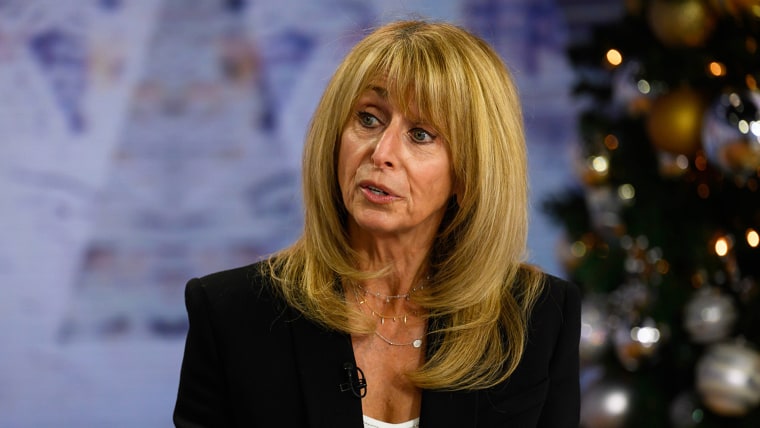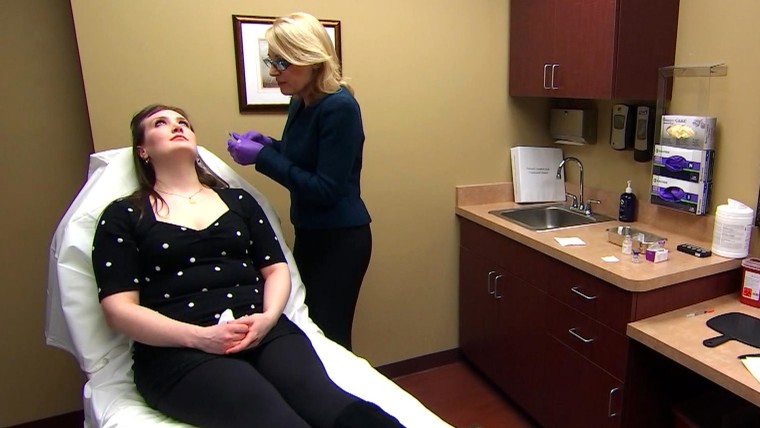Over the past two years, Awnuh, 19, has undergone a variety of cosmetic procedures: cheek filler, lip filler, breast augmentation and rhinoplasty.
They are pricey procedures. Her first, for lip filler, cost about $1,200, paid for with money she made by posting explicit content to her OnlyFans account, which she started the day she turned 18. Since then, her online popularity has soared, particularly on TikTok, where she posts about her physical transformation and her 60-plus tattoos to more than 415,000 followers.
That following has made it easier to afford increasingly aggressive and invasive cosmetic procedures and surgeries. More followers means more money, but also bigger discounts from the array of surgeons, clinics and medical spas (more commonly known as med spas) that now see influencers as the cheapest and most effective way to attract new customers.
Awnuh said she realizes she could be influencing her fans to follow in her footsteps, modeling the pursuit of online fame via explicit content that results in free or discounted cosmetic procedures. Her most recent procedure, a “lip blush” that deposits reddish-pink pigment in the lips through a tattoo-like process, was $200 off a $600 treatment in return for a TikTok post. That video has been viewed more than 6 million times.
“I try to be as open as possible, but I also don’t want to be in a position where I’m flaunting, like ‘Hey, look, I get these free procedures,’” said Awnuh, who spoke on the condition of using her online handle rather than her real name, out of privacy concerns. “I know a lot of my audience is younger girls and I don’t want to flex, like ‘I got popular off OnlyFans, and now I get all this free stuff.’”
“Back in the day, surgeons didn’t advertise. … Now they’re advertising with young people, and they’re popular on all the social media networks, like TikTok and Instagram.”
Lorry Hill, cosmetic surgery enthusiast
It’s a dynamic that many young social media personalities now experience, a feedback loop of free or cheap cosmetic procedures that also boost their views, which in turn make them even more lucrative targets for clinics and practitioners selling such procedures.
From Botox to breast implants, medical providers have turned to social media for a new kind of personalized advertising that comes directly from influencers. And in the growing industry of cosmetic providers, there are few to no rules when it comes to advertising body modifications, which opens the door to offering teenagers free, unlimited cosmetic procedures.
NBC News spoke with 12 social media personalities with audiences ranging from under 100,000 to more than 10 million followers who detailed how they feel pushed to look perfect in real life and online. This has led younger creators in their teens and early 20s to get cosmetic procedures, ranging from lip filler injections to plastic surgery — many of which they received at discounted rates. Many expressed regrets about some of their procedures. Six of them described feeling addicted to body modification.
“If you have an iPhone, it has affected you,” Sebastian Bails, a TikTok star with 12.8 million followers, said. He said he got his first cosmetic procedure, lip filler injections, when he was 18.
“I got my lips done, not because I was insecure, but because I was offered free lips,” he said. “Who is going to say no to free lips?”
The industry
For years, the plastic surgery industry has been boosted by social media, popularizing certain procedures as beauty standards evolved.
That has in turn changed how these procedures are marketed. Lorry Hill, a cosmetic surgery enthusiast who runs a beauty-focused YouTube channel, said she’s seen a significant increase in the willingness of cosmetic-procedure providers to advertise through social media influencers.
“Back in the day, surgeons didn’t advertise. It was shameful,” she said. “Now they’re advertising with young people, and they’re popular on all the social media networks, like TikTok and Instagram.”
Hill said she has observed cosmetic physicians posting mostly young patients on their Instagram and TikTok accounts.
On TikTok, hashtags for videos about “plasticsurgery” and “lipfiller” have 26 billion views combined, according to data from the company’s hashtag pages. Those pages are filled with people of many ages sharing their experiences with various procedures.
“If you have an iPhone, it has affected you.”
Sebastian bails, who had his first cosmetic procedure at 18
TikTok differentiates between organic advertising and branded advertising on its platform, and it doesn’t allow cosmetic procedures or providers to advertise through official TikTok ads. Those rules don’t apply to videos like Awnuh’s, which aren’t considered branded advertising.
“We strive to be as transparent as possible with our community and expect the same from those on our platform,” a TikTok spokesperson said in an email. “This is why we require that users disclose when they develop branded content. When we discover that this isn’t the case, we take steps to address it.”
Industry professionals also say they’ve seen more extreme demands from young patients.
“There are a lot of early 20-year-olds who have a form of body dysmorphia where they say ‘This is too small, this is too big,’” said Kristin Gunn, a Texan medical spa owner who performs a variety of nonsurgical cosmetic procedures. “They’re comparing, comparing, comparing to Instagram and all this stuff, ‘I need my butt bigger, I need all of these things.’”
The American Med Spa Association didn’t respond to requests for comment about advertising practices in the industry.
Dr. Ashley Amalfi of the American Society of Plastic Surgeons said in an email that her group has a code of ethics that applies to advertising.
“We’re aware that young people are watching and we always try to approach things ethically, professionally and to have a message of a positive body image, especially for young girls,” she wrote. “It’s important that we abide by all of those standards and to uphold them especially for our youngest audience.
Young people still account for a small portion of the broader plastic surgery market, but are a growing part of the industry.
Dr. Steven Williams, a board-certified plastic surgeon practicing in Oakland, California, said patients seeking filler and other nonsurgical treatments are trending younger.
“The entire business model of social media is the obtainment of the unattainable,” he said. “That inherently drives people to try and reach that unattainable goal, and sometimes they use plastic surgery to try and get there.”
Williams added that social media can also underplay the seriousness of many procedures.
“These are all medical treatments,” he said. “Even though social media tends to trivialize them, they can all have very serious implications for a patient’s health.”
The regulation
The Food and Drug Administration has approved the use of filler (compounds that can be injected and then safely absorbed into the body) for adults over the age of 22, but that doesn’t mean younger patients can’t get them. A consenting adult or a minor with a parent’s permission can instead receive “off-label” fillers, which are fillers used in a way that are not covered by FDA guidelines.
Individuals between ages 20 and 29 only receive 3 percent of total filler procedures and only 1 percent of total Botox procedures, according to 2020 data collected from the American Society of Plastic Surgeons’ pool of board-certified surgeons. Teenagers make up an even lower percentage, according to the same data.
But that data doesn’t account for med spas, an industry valued at $4.8 billion in 2021, that is loosely regulated. The spas have become popular destinations for simple procedures such as Botox and fillers.
The regulation of invasive plastic surgeries is relatively straightforward. Those must be performed by licensed physicians, who are regulated by state medical boards. The American Board of Plastic Surgery also credentials doctors.
The regulation of less invasive procedures such as Botox and fillers is less clear. There is no federal oversight, and in most states, many nonsurgical treatments can be performed by unlicensed people overseen by a physician (though in many states, a doctor is supposed to make a diagnosis for any procedure). According to 2019 data collected by the American Association of Med Spas, 36 percent of medical spas operate without a medical director at all.
Even when med spas have a physician on staff, the amount of time the physician spends at the facility can vary widely. A survey published in the journal Dermatologic Surgery in 2019 found that of med spas with board-certified medical directors, 52 percent said the doctor was on site less than half the time.
“State authorities have not kept up with this explosive growth, leaving American medspas in a regulatory gray area, as many of the services they provide seem to fall between the performance of traditional esthetic services, e.g., hairstyling and manicures, on the one hand, and traditional medical practice, e.g., the diagnosis of disease and surgery, on the other.” lawyers for the law firm Pillsbury Winthrop Shaw Pittman wrote in a blog post.
There are some examples of local authorities taking action, though they are relatively rare. In February, two men in Las Vegas were charged with performing procedures at a beauty spa without the proper licenses. Their case is ongoing.
The deals
While influencers talk openly about the relationship between social media and cosmetic surgery, they can be less transparent about the financial arrangements.
Some cosmetic practitioners seek out influencers with large, young followings to advertise their services — and those advertisements aren’t always labeled as ads. Awnuh said she labeled her lip blush video as a “shoutout” to the provider at their request, rather than using the hashtag “ad” that the Federal Trade Commission suggests influencers display prominently in endorsements. According to the agency guidelines which are enforceable under the FTC Act, material connections between advertising companies and endorsers must be fully disclosed. A representative for the agency said that “failing to disclose such a connection could be a violation of the FTC Act.”
Despite FTC rules and guidelines, influencers are still sometimes encouraged to post advertisements disguised as vlogs or “before and after” videos, which seem more authentic and have more viral potential than a clearly labeled endorsement.
Beyond filler, some influencers say that the trendy injectables popularized on social media can act as a gateway to more expensive, long-lasting and risky plastic surgeries.
Gunn said social media advertisements for cosmetic procedures and plastic surgery are an unregulated “Wild West,” but that word of mouth and social media are her med spa’s entire advertising strategy. While she said she doesn’t ask patients with large followings to post about their procedures or tag her, they sometimes do so on their own accord, and she’ll discount their future services as a thank you.
“It’s crazy how one thing is wildfire, and you don’t have to pay for it. It’s free,” Gunn said. “And so we take really good care of those people.”
Some influencers have begun confronting the dynamics that they view as problematic between young people and cosmetic procedures.
Ashly Schwan, 24, who has more than 400,000 Instagram followers, said that she was offered free fillers and cosmetic procedures even when she had a smaller following. She said she went overboard, getting free filler every few months.
“I’ve learned through those experiences that free filler might not always be a good idea,” she said.
She’s documented her “filler journey” on TikTok.
“I wish I had someone to tell me like ‘No, don’t get more filler,’” Schwan said in a video about her lip filler on her account. “I look cute other than the fact that the filler was moving into my mustache area.”
Gunn said she refuses to fulfill extreme body modification requests.
“If I have a 22-year-old who comes in and wants something I don’t think is good for them, I’ll say ‘Come back in five years,’” she said. “I know they’ll go up the street and get it, but I sleep well at night.”
The pressure
Awnuh and 11 other young people who make a living online and spoke with NBC News said that the pressure to meet beauty standards has only become worse in recent years.
When Awnuh gets an offer for a free or discounted cosmetic procedure in exchange for a TikTok post, she said she has to take a step back: “Am I getting this because I got a discount and I want to conform to beauty standards, or is it something I actually want?”
“It’s something I worry my audience feels as well,” she said. “Not saying I’m a role model, but just in case, I always want to be clear that I get things because I want to, and that I’m not promoting that anyone change themselves or get procedures they don’t want.”
Bails, 22, said the success he saw in his teenage years led him to try more extreme procedures, many of which he received at a discount.
“When I started changing my appearance, the likes and views and shares went up,” he said. “People will say it looks like an alien, it looks crazy. I fed into that. I love that. That’s why I do social media, I love attention.”
What started with freebies turned into Bails paying a celebrity plastic surgeon to make drastic changes to his jawline and cheekbones with facial filler, a procedure he said he hasn’t been able to afford since.
“It was filler, but it was so much filler. I had almost twenty syringes in my face,” he said. “When I walked out of the doctor’s office, I was so freaked out, because I looked like Maleficent.”
Bails said he regrets that he “ruined” his face. Now, he swears by Botox, which he said he sometimes gets offered for free, and is contemplating more permanent surgery options.
“Health is really important, but it’s almost like your image becomes more important when you’re in this world of social media,” he said. “There are a lot of complications that can go wrong. But I’m willing to take that risk so I can look good online.”
This story first appeared on NBCNews.com.
Related:



